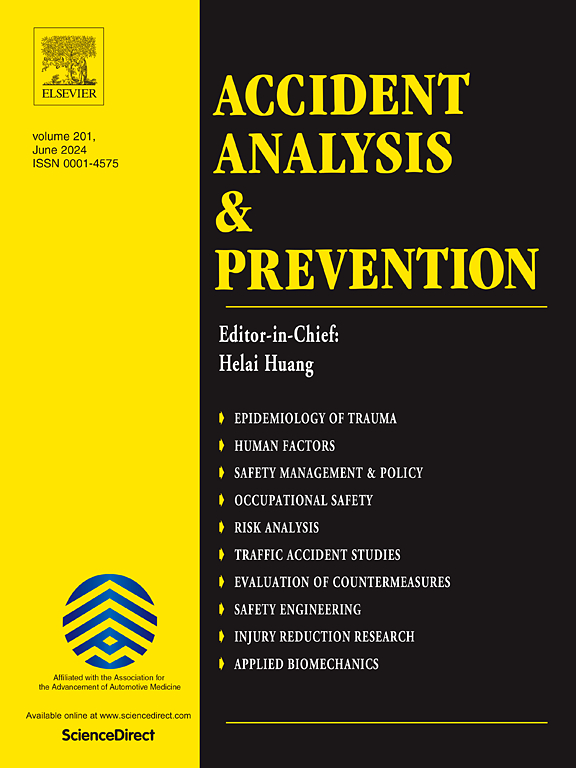对肯塔基州农村多车道路段摩托车碰撞频率进行建模
IF 6.2
1区 工程技术
Q1 ERGONOMICS
引用次数: 0
摘要
尽管摩托车事故占美国交通死亡人数的很大比例,但调查摩托车事故频率的研究相对有限。该研究率先在肯塔基州农村多车道路段开发了摩托车碰撞特定安全性能功能(spf),分别适用于covid -19大流行前(2015-2019)和covid -19大流行后(2020-2022)时期。收集并使用了8年的摩托车碰撞记录(2015年至2022年)和特定地点的特征(例如肩宽和年平均日交通“AADT”)。在考虑摩托车碰撞分散不足(即碰撞方差小于其平均值)的情况下,拟合康威-麦克斯韦-泊松(CMP)和异质性康威-麦克斯韦-泊松(HTCMP)模型并进行比较。研究结果表明,在大流行前和大流行后,HTCMP模型在各种拟合度度量(如似然比检验“LRT”、Akaike信息准则“AIC”和McFadden伪r平方)和预测性能度量(即平均绝对偏差“MAD”和均方预测误差“MSPE”)上都优于CMP模型。从发达的高速公路来看,在大流行前,水平曲线和未分割道路的存在与农村多车道路段摩托车碰撞频率增加显著相关,而在大流行后,更宽的右肩和更高的AADT与摩托车碰撞频率增加显著相关。应用最佳拟合模型(即HTCMP模型)预测的碰撞频率,然后用于识别肯塔基州农村多车道高碰撞路段并对其进行排名。根据研究结果,提出了改善肯塔基州农村多车道路段摩托车驾驶员安全的若干对策,如在未划分的农村多车道道路上增加中心线槽隆隆带。本文章由计算机程序翻译,如有差异,请以英文原文为准。
Modeling motorcycle crash frequency on rural multilane segments in Kentucky
Despite motorcycle crashes accounting for a large percentage of traffic fatalities in the U.S., studies investigating motorcycle crash frequency are relatively limited. This study took the initiative and developed motorcycle crash-specific safety performance functions (SPFs) along rural multilane road segments in Kentucky, separately for the pre-COVID-19 pandemic (2015–2019) and post-COVID-19 pandemic (2020–2022) periods. Eight years of motorcycle crash records (2015 through 2022) and site-specific characteristics (e.g., shoulder width and annual average daily traffic “AADT”) were collected and used. Conway-Maxwell-Poisson (CMP) and heterogeneous Conway-Maxwell-Poisson (HTCMP) models were fitted and compared while accounting for motorcycle crash under-dispersion (i.e., when crash variance is less than its mean). The study results showed that, for both pre- and post-pandemic periods, the HTCMP models outperformed their CMP counterparts based on various goodness-of-fit measures (e.g., likelihood ratio test “LRT”, Akaike information criterion “AIC”, and McFadden pseudo R-squared) and prediction performance measures (i.e., mean absolute deviance “MAD” and mean square prediction error “MSPE”). From the developed SPFs, for the pre-pandemic period, the presence of horizontal curves and undivided roadways were significantly associated with increased motorcycle crash frequency along rural multilane segments, while in the post-pandemic period, wider right shoulders and higher AADT were significantly associated with increased motorcycle crash frequency. The predicted crash frequencies while applying the best-fit models (i.e., the HTCMP models) were then used to identify and rank high-crash rural multilane segments in Kentucky. Based on the study findings, several countermeasures were proposed to improve motorcyclists’ safety along Kentucky’s rural multilane segments, e.g., adding centerline grooved rumble strips along undivided rural multilane roadways.
求助全文
通过发布文献求助,成功后即可免费获取论文全文。
去求助
来源期刊

Accident; analysis and prevention
Multiple-
CiteScore
11.90
自引率
16.90%
发文量
264
审稿时长
48 days
期刊介绍:
Accident Analysis & Prevention provides wide coverage of the general areas relating to accidental injury and damage, including the pre-injury and immediate post-injury phases. Published papers deal with medical, legal, economic, educational, behavioral, theoretical or empirical aspects of transportation accidents, as well as with accidents at other sites. Selected topics within the scope of the Journal may include: studies of human, environmental and vehicular factors influencing the occurrence, type and severity of accidents and injury; the design, implementation and evaluation of countermeasures; biomechanics of impact and human tolerance limits to injury; modelling and statistical analysis of accident data; policy, planning and decision-making in safety.
 求助内容:
求助内容: 应助结果提醒方式:
应助结果提醒方式:


